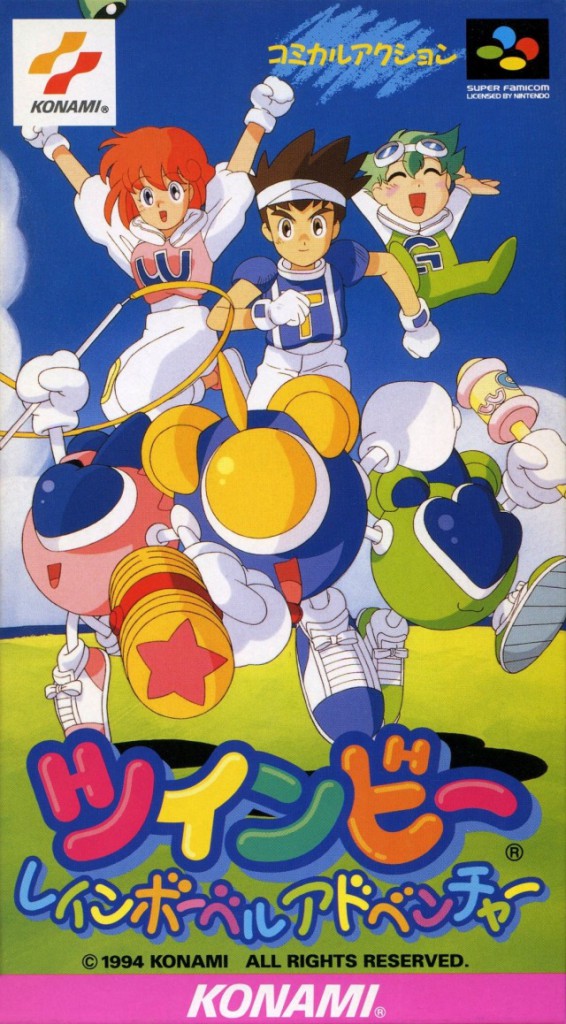
Pop’n Twinbee is a SHMUP on the Super Famicom, but Konami originated the series in the arcade way back in 1985 (Twinbee). Pop’n Twinbee Rainbow Bell Adventures is an action platformer that feels like a trip on acid. It’s colorful, wild and a bit ridiculous. It’s also a hell lot of fun.
Select from TwinBee, WinBee or GwinBee. Each one has their own strengths and weaknesses. There is a punch and jump meter, and the length of each one varies from character to character.
TwinBee attacks with a mallet, but only after you’ve collected the proper bell. His punch and jump meters are evenly balanced.
WinBee attacks with a lasso after procuring the proper bell. Her punch meter is long but her jump meter is super short, making her the ideal character for those who like to rack up frequent flyer miles.
GwinBee throws those rattles once you’ve nabbed the proper bell. He’s the opposite of WinBee — his jump meter is awfully long but his punch meter is extremely short.
So, what happens when the punch meter is fully charged? Well, this!
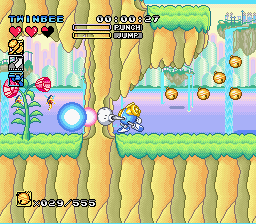
It can be shot in any one of eight directions. This mega shot allows you to break certain sections of the landscape that otherwise impedes your progress.
What about the jump meter… what happens when it’s fully charged? Well, this!
It zips you across the screen in your direction of choice (like the mega shot you can aim it in any one of eight directions). It also breaks barriers as such.
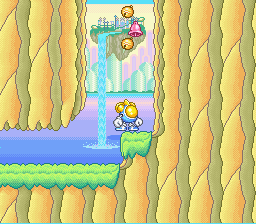
Killing enemies and collecting the various colored bells is the name of the game. Each color grants you a different skill or power-up. Unfortunately whenever you take damage you lose all your bells, but just kill more enemies to recollect them.

Each of the three characters can shoot a gun when a blue bell is collected. This gives all of the characters a long range shot that can be fired at any time at will. Yes, they can fire the mega shot too but obviously there is a charge time for that. On the downside, the gun cannot break barriers. It also can only be shot straight ahead. It’s nice that the game gives you choices but each choice has its own pros and cons. I love it when games do that. Makes it feel very versatile!
You can do some crazy flying in this game, including soaring into the outer reaches of space as the game starts to highlight your kilometers in the air after a certain height. It gets pretty ridiculous!
You can also float in mid-air as you recharge your jump meter. Or you can cancel the float and descend as normal. Again, options and choices. This game excels at giving you that.
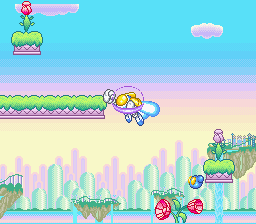
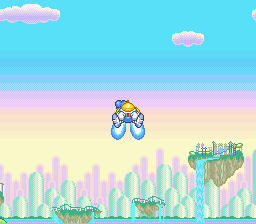
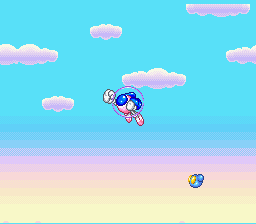
Fly all over the place — you never know when you might crash through some breakable walls to discover “hidden” goodies!

Yeah, the mega shot and the gun is fun to use, but sometimes you just can’t beat smashing a bad guy over the head with a good old fashioned mallet. Good times.

To top off this fun little game, you have a password system to save your progress. There are also two 2-player modes. The first is a co-op mode that gets a little crazy. That’s because it’s easy to leave your partner behind when one of you decides to take flight. It’s nice to see Konami included this 2-player mode but truth be told it’s not the best co-op game in the world as it’s far too easy to get caught off-screen unless you and your friend are determined to stick together. The second mode is a battle mode. This is a split screen 3 minute war where both players are pitted against one another in a duel to the death. It’s an interesting option for sure as I can’t think of many SNES 2-player games that feature such a barbaric option. If you can think of another one, sound off in the comments. Hell, it’s possible this might in fact be the only one of its kind!
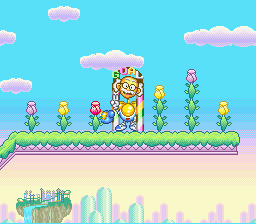
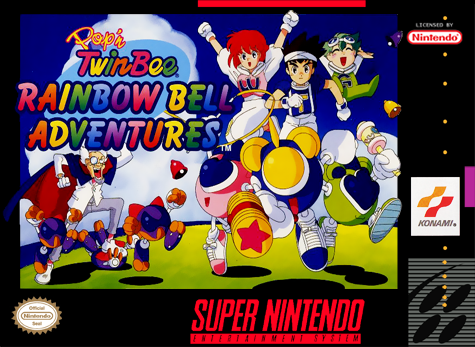
CLOSING THOUGHTS
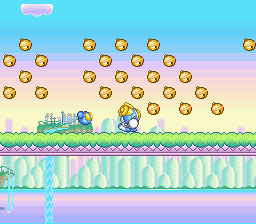
Pop’n Twinbee Rainbow Bell Adventures is a fun and delightful action platformer. It’s easily one of Konami’s best SNES games never to hit the US. There was a PAL European release, however. The game has some quirky and entertaining gimmicks backing it, making it a unique experience in a world bloated with way too many hop and bop affairs. The visuals are so sugary sweet that you just might get a cavity just by looking at it. The sound is typical Konami goodness. And the gameplay is different, challenging enough and definitely loads of fun. You can’t go wrong with Rainbow Bell Adventures. Konami could do almost no wrong back in the mid ’90s, and this is simply another shining example of such.
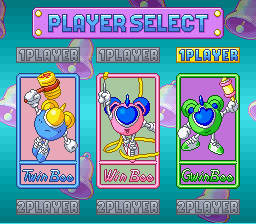
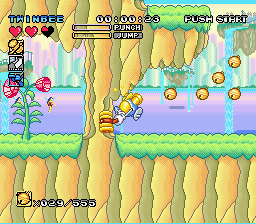
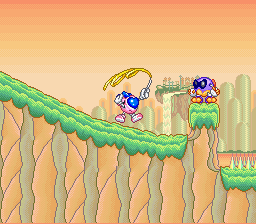

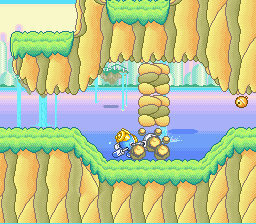

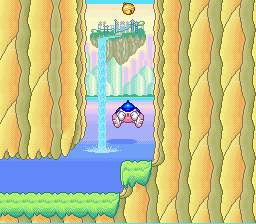
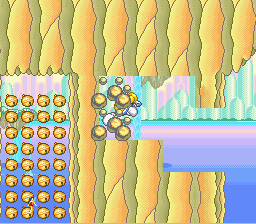
Ah, TwinBee: Rainbow Bell Adventure (localized in Europe as Pop’n TwinBee: Rainbow Bell Adventures… it was important for Konami to pluralize the last word in the subtitle, I guess), the fifth Super Famicom cartridge I got back in the Summer of 2012 (almost a decade ago already?), such a great game, and I agree it’s among the best Konami made for the Nintendo 16-bit console! =D I’ve been playing it again after several years (I’m playing it now) and I still think it’s such a great platformer!
I think it was a novel approach for Konami to go in this direction for the cute’em up series’ spinoff: the sentient ships TwinBee, WinBee, and GwinBee all have arms and legs and they all have a likable charm… why *not* make into them platforming heroes? And the great thing is that it works as good as it sounds. The gameplay is fun and intuitive as it retains the bell power-up system from the TwinBee cute’em ups while also combining elements influenced from other games; the jetpack gadgetry from Konami’s own Rocket Knight Adventures, the occasional need for speed from Sega’s Sonic the Hedgehog franchise (provided there are no enemies to worry about, there are plenty of inclines to run down on however), and the lookaround feature from Accolade’s Bubsy in Claws Encounters of the Furred Kind (not just taking a peak above or below you but from across from you or far behind you via the shoulder buttons, which if nothing else is innovative for a 2D platformer as it clearly rubbed off on this game, Iguana Entertainment’s Aero the Acro-Bat, and Phoenix Interactive Entertainment’s Porky Pig’s Haunted Holiday to very helpful effect) which is very helpful in spots.
I love the pastel-toned visuals throughout and how relaxing they are for the eyes, such as the areas that transpire in the depths of the forest with the occasional waters to swim in, the icy and frigid realm with the aurora borealis in the sky, and the dark mines with the soft vignette filter to make anything outside the circle darker. The soundtrack is fantastic, I love the playful variety of themes that lend so much to the atmosphere (the opening theme is so bouncy and fun, it’s easy to sway to the relaxing theme of one of the forest themes as it’s so calm sounding, the snow theme evokes a sense of atmospheric wonder, and the toy land theme is upbeat and lighthearted).
I enjoy the fact that the heroic trio have a difference in charging their gauge with their jump and punch (as opposed to just their different yellow bell weapons of choice; be it hammer, or ribbon, or long-ranged rattle projectile); with WinBee having a shorter jump gauge which makes blasting off a breeze and GwinBee having a shorter punch gauge to ensure that he charge up his blast as quickly as possible, and the title character TwinBee joining the likes of Cody in Capcom’s Final Fight, Hii in Affect’s Cacoma Knight, and Kamll/Kamil Dowonna in Produce’s Elnard/The 7th Saga as the blue-colored median character who’s more balanced than either of his compatriots.
I only played the original Super Famicom version, but I know the European version has differences: it only implements a password system compared to the Japanese version where it had both a battery save *and* a password system (either can be chosen), the dialogue between Dr. Cinnamon and the three Bees in the map screen was removed completely, the map layout is more linear than the Japanese version’s more open-ended one, and it only has one ending versus the Super Famiversion having multiple depending on how many stages you cleared (Did you access all the exits? Did you find all the keys? Did you find all the fairies? If you did, get ready for a harder than normal showdown against Dr. Warumon, I know it caught me off-guard the first time).
I remember reading years ago how HAL Laboratory (or Nintendo) removed the entire introduction of Kābī Bowl when it came to the Western version Kirby’s Dream Course in order to reduce the cost of localization (to put it simply), which got me thinking: perhaps Sony Imagesoft’s removal of the towns and dialogue in the American version of System Sacom’s Jerry Boy (published in Japan by Epic/Sony Records), Smart Ball, may have been due to reducing the cost of localization (and not having enough resources)? Admittedly, that’s pure conjecture, but looking at it in a logical perspective it sorta makes sense, and makes me wonder if Konami may have simplified it in order to reduce localization costs? Again, it’s conjecture, but who knows? *shrugs*
The fact that there are multiple endings and the way each of the main character have different gauge lengths with their jump and punch I feel adds so much to the replay value; looking very thoroughly in each area can be a lot of fun as there are certain instances where you might walk through a wall in certain inconspicuous spots, and the series’ adorably lighthearted charm is so endearing and likable (each character has a different idle pose, I love how this one mega punch move launches your foes into the backdrop, and I find it cute how if you run for awhile but don’t jump over the rock along the way TwinBee, WinBee, or GwinBee trips). And really, how often do you find a platformer where you can skyrocket your character up to the cosmos all the way up to 9999 km? It’s awesome! =D
TwinBee: Rainbow Bell Adventure is not only, in my opinion, a super great entry in Konami’s cute’em up franchise (one of the best, actually, alongside Pop’n TwinBee and TwinBee: Yahho!), not only is it one of their best in the Nintendo 16-bit console, but it’s also a very enjoyably well-crafted platformer on its own merits. I love it!
Have a great day, and take care!
To each their own
Wow almost 10 years ago! How time flies. Yes, this was a fine, fine Konami entry in their impressive SNES career. Thanks for sharing some cool facts about this game. I didn’t know that about the differences between the European and Japanese versions. Very cool to have a save AND password option in the Japanese version. This is one of those 2 player games that I need to try out with the wife. Right now we’re sort of playing through Lost Vikings 2, although we haven’t picked it up a few months now due to planning for a baby shower and everything. Always good to hear from ya!